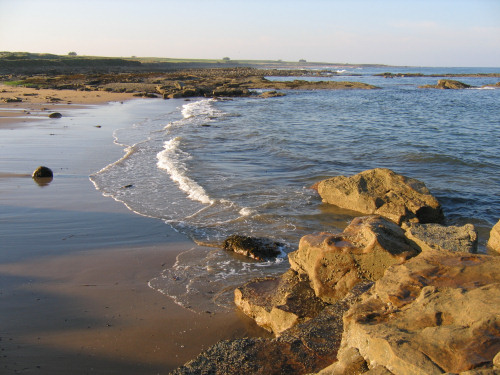
Established 2002
Lucinda Shepherd, friend Robert Randell and various experts for their support.
Kingsbarns (Fife)

Click above to view page as a PDF.
Click here to download PDF software.
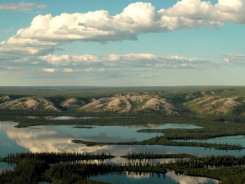
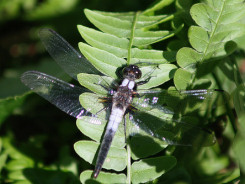
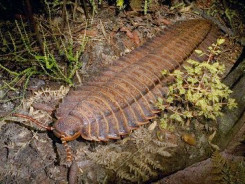
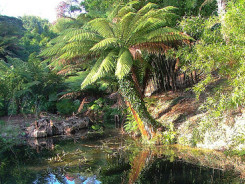
Introduction
Kingsbarns is located on the east coast of Fife in Scotland and provides an opportunity to find plant remains dating from the Carboniferous period 335 million years ago. At low-tide the retreating sea exposes a variety of fossils in situ, in particular the roots of the Lepidodendron tree (Stigmaria) which once grew commonly in this part of the world.

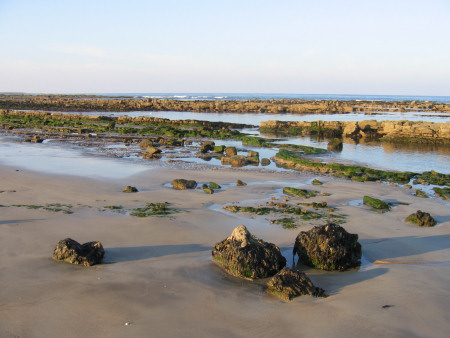
Left: Plenty of
parking is available at the beach access point. Right:
The foreshore exposed at low-tide.
Parking is available at the beach car park, from which a small path leads to the beach (see above-left). Although fossils can be found throughout the exposures, most are in situ and are best left for others to enjoy too. Fortunately a small volume of loose material at the top of the beach provides occasional finds worth keeping.
The geology of Kingsbarns
The rocks at Kingsbarns were formed within an expansive delta system during the Carboniferous period (Visean stage), approximately 335 million years ago. Much of the rock exposed today was formed by sediment (sands and silts), carried and deposited by rivers across the region. This period represents a great change in the earth's history, with land plants evolving into large trees and ferns, and amphibians, reptiles and giant flying insects inhabiting the humid forests.

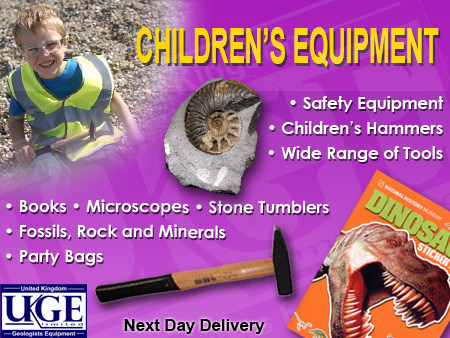
ADVERTISEMENT BY UKGE - OFFICIAL ADVERTISING PARTNER OF DISCOVERING FOSSILS
Where to look for fossils?
Unlike other collecting locations, the fossils at Kingsbarns are not apparently obvious and visitors will need to spend some time searching the area to find a productive spot. Fossils can be found in situ on the exposed foreshore at low-tide and within the eroded rock face at the top of the beach. During a single visit visitors are likely to encounter several fossils in situ, in particular roots belonging to the Stigmaria tree and ripple marks formed within the prehistoric sediment.

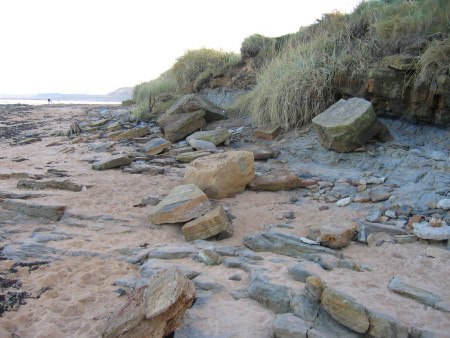
Left: Plant fossils
can be found in situ on the foreshore at low tide. Right:
Fossils can also be found within lose boulders where the sea has
eroded the coast.
Due to the low frequency of situ fossils, we recommend leaving them for others to enjoy; collecting efforts are best concentrated on the lose boulders and pebbles located at the base of the low-cliff at the top of the beach.
As with all coastal locations, a fossil hunting trip is best timed to coincide with a falling or low-tide. For a relatively low one-off cost we recommend the use of Neptune Tides software, which provides future tidal information around the UK. To download a free trial click here. Alternatively a free short range forecast covering the next 7 days is available on the BBC website click here.
What fossils might you find?
The most common fossils along this stretch of coast are the trunk and roots of Lepidodendron trees, which appear in situ of the foreshore. The bark is identifiable by its characteristic diamond-shaped leaf cushions, whereas the roots (known commonly as Stigmaria) are covered by a series of small pits (see below-left), from which smaller root appendages grew. Some Lepidodendron species could grow up to 40 metres; the roots spread horizontally, indicating humid environments.

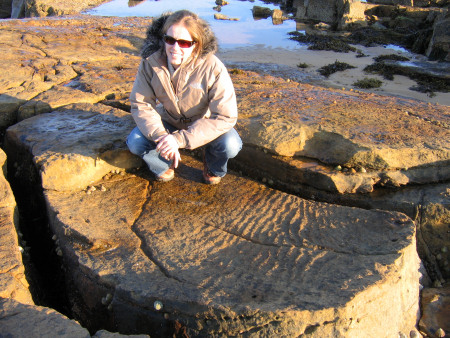
Left: A section of
Lepidodendron trunk in situ on the exposed foreshore.
Right: Clearly defined prehistoric ripple marks
exposed at low-tide.

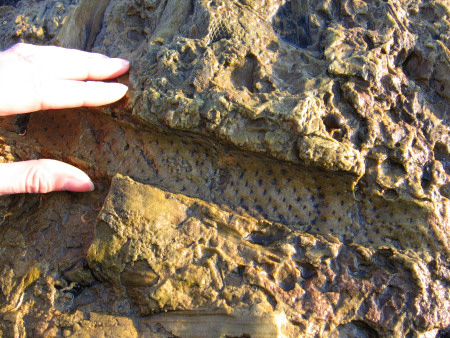
Left: A beach
pebble containing a concentration of bivalve shells. Right:
The impression of a Stigmaria (tree root).
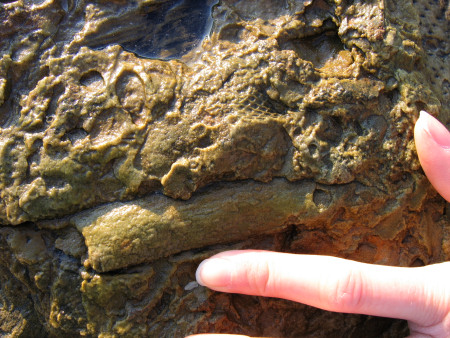

Left: A small
section of tree stem. Right: A heavily sea worn
section of Stigmaria exposed on the foreshore.


Left: A small
section of plant stem. Right: A worn fragment of
Stigmaria.
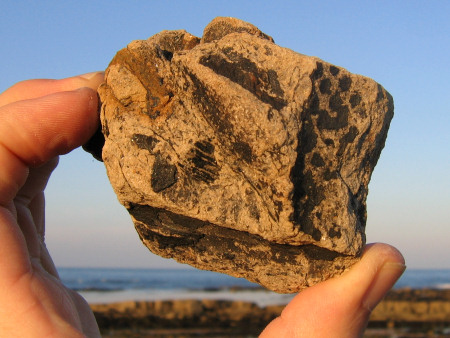
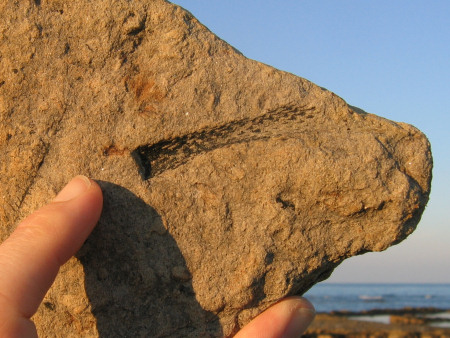
Left: A split beach
pebble containing a concentration of plant remains. Right:
The impression of a thin plant stem, possibly a juvenile
Lepidodendron.
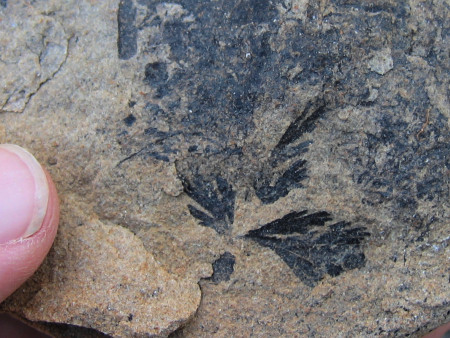
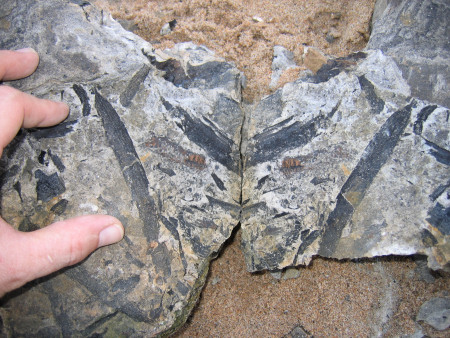
Left: A split beach
pebble containing a three part leaf. Right: A
large boulder split in half to reveal a mass of plant remains.
Tools & equipment
It's a good idea to spend some time considering the tools and equipment you're likely to require while fossil hunting at Kingsbarns. Preparation in advance will help ensure your visit is productive and safe. Below are some of the items you should consider carrying with you. You can purchase a selection of geological tools and equipment online from UKGE.
Hammer: A strong hammer will be required to split prospective rocks. The hammer should be as heavy as can be easily managed without causing strain to the user. For individuals with less physical strength and children (in particular) we recommend a head weight no more than 500g.
Chisel: A chisel is required in conjunction with a hammer for removing fossils from the rocks. In most instances a large chisel should be used for completing the bulk of the work, while a smaller, more precise chisel should be used for finer work. A chisel founded from cold steel is recommended as this metal is especially engineered for hard materials.
Safety glasses: While hammering rocks there's a risk of injury from rock splinters unless the necessary eye protection is worn. Safety glasses ensure any splinters are deflected away from the eyes. Eye protection should also be worn by spectators as splinters can travel several metres from their origin.
Strong bag: When considering the type of bag to use it's worth setting aside one that will only be used for fossil hunting, rocks are usually dusty or muddy and will make a mess of anything they come in contact with. The bag will also need to carry a range of accessories which need to be easily accessible. Among the features recommended include: brightly coloured, a strong holder construction, back support, strong straps, plenty of easily accessible pockets and a rain cover.
Walking boots: A good pair of walking boots will protect you from ankle sprains, provide more grip on slippery surfaces and keep you dry in wet conditions. During your fossil hunt you're likely to encounter a variety of terrains so footwear needs to be designed for a range of conditions.
For more information and examples of tools and equipment recommended for fossil hunting click here or shop online at UKGE.


ADVERTISEMENT BY UKGE - OFFICIAL ADVERTISING PARTNER OF DISCOVERING
FOSSILS
Protecting your finds
It's important to spend some time considering the best way to protect your finds onsite, in transit, on display and in storage. Prior to your visit, consider the equipment and accessories you're likely to need, as these will differ depending on the type of rock, terrain and prevailing weather conditions.


Left: Fossil
wrapped in foam, ready for transport. Right:
A small compartment box containing cotton wool is ideal for
separating delicate specimens.
When you discover a fossil, examine the surrounding matrix (rock) and consider how best to remove the specimen without breaking it; patience and consideration are key. The aim of extraction is to remove the specimen with some of the matrix attached, as this will provide added protection during transit and future handling; sometimes breaks are unavoidable, but with care you should be able to extract most specimens intact. In the event of breakage, carefully gather all the pieces together, as in most cases repairs can be made at a later time.
For more information about collecting fossils please refer to the following online guides: Fossil Hunting and Conserving Prehistoric Evidence.
Join us on a fossil hunt
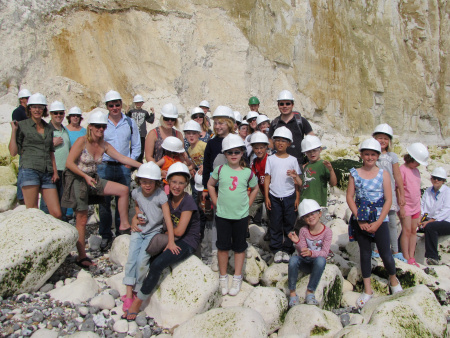

Left: A birthday party with
a twist - fossil hunting at
Peacehaven.
Right: A family hold their prized ammonite at Beachy Head.
Discovering Fossils guided fossil hunts reveal evidence of life that existed millions of years ago. Whether it's your first time fossil hunting or you're looking to expand your subject knowledge, our fossil hunts provide an enjoyable and educational experience for all. To find out more CLICK HERE






